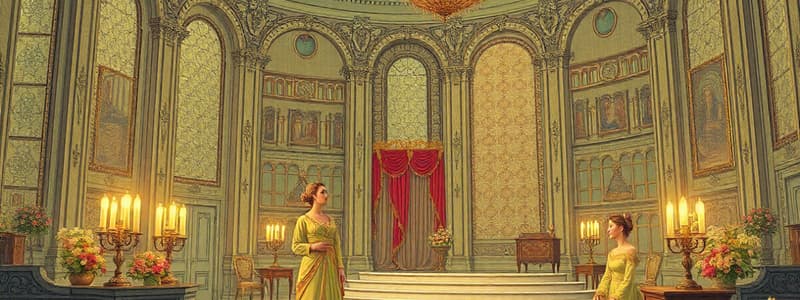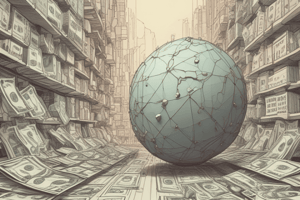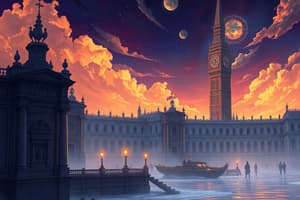Podcast
Questions and Answers
Which of the following statements accurately reflects the SC's position on the Memorandum of Procedure (MoP) for judicial appointments?
Which of the following statements accurately reflects the SC's position on the Memorandum of Procedure (MoP) for judicial appointments?
- The SC has consistently argued for a MoP that gives absolute control over judicial appointments to the judiciary.
- The SC advocates for complete removal of the executive's role in judicial appointments, deeming it unnecessary.
- The SC has acknowledged the need for a more balanced MoP, but the precise formulation remains a point of contention. (correct)
- The SC believes that the MoP, as it currently exists, is entirely satisfactory and requires no modification.
Under Article 143, when can the President seek an opinion from the Supreme Court?
Under Article 143, when can the President seek an opinion from the Supreme Court?
- On any question of law or fact that is of public importance. (correct)
- Solely on matters pertaining to the interpretation of pre-constitutional treaties or agreements.
- On any matter of law or fact, regardless of its importance to the public domain.
- Exclusively on matters related to the interpretation of the Constitution.
Which of the following statements accurately differentiates the writ jurisdiction of the High Courts (HCs) and the Supreme Court (SC)?
Which of the following statements accurately differentiates the writ jurisdiction of the High Courts (HCs) and the Supreme Court (SC)?
- The SC's writ jurisdiction is broader than HCs because it can issue writs against both the government and individuals.
- The SC's writ jurisdiction is limited to enforcing fundamental rights, while HCs have a broader jurisdiction. (correct)
- HCs have no writ jurisdiction, while the SC has exclusive jurisdiction over all writ petitions.
- The SC and HCs have identical writ jurisdiction, with no distinction between the two.
Which of the following statements accurately describes the "collegium system" of judicial appointments?
Which of the following statements accurately describes the "collegium system" of judicial appointments?
Which of the following statements accurately reflects a key difference between the original Article 124 of the Constitution and the current practice of judicial appointments?
Which of the following statements accurately reflects a key difference between the original Article 124 of the Constitution and the current practice of judicial appointments?
What is the legal basis for an appeal to the Supreme Court on a criminal matter?
What is the legal basis for an appeal to the Supreme Court on a criminal matter?
What is the key argument against the "collegium system" for judicial appointments?
What is the key argument against the "collegium system" for judicial appointments?
What is the key argument in favor of the "collegium system" for judicial appointments?
What is the key argument in favor of the "collegium system" for judicial appointments?
What is the legal basis for the Supreme Court's jurisdiction over disputes arising out of elections for the President and Vice-President?
What is the legal basis for the Supreme Court's jurisdiction over disputes arising out of elections for the President and Vice-President?
What was the apex court's stance on the existing Memorandum of Procedure (MoP) in December 2015?
What was the apex court's stance on the existing Memorandum of Procedure (MoP) in December 2015?
Under what condition can the President's Rule be extended beyond one year?
Under what condition can the President's Rule be extended beyond one year?
What is the maximum duration for which the President's Rule can be imposed?
What is the maximum duration for which the President's Rule can be imposed?
What was the significant contribution of the SR Bommai case to the President's Rule?
What was the significant contribution of the SR Bommai case to the President's Rule?
What is the primary criticism raised by the Supreme Court regarding the frequent use of Article 356?
What is the primary criticism raised by the Supreme Court regarding the frequent use of Article 356?
Which of these situations is considered a proper use of the President's Rule?
Which of these situations is considered a proper use of the President's Rule?
What is the Supreme Court's position on the dissolution of the state legislative assembly before the parliamentary approval of the President's Rule?
What is the Supreme Court's position on the dissolution of the state legislative assembly before the parliamentary approval of the President's Rule?
Based on the Sarkaria Commission's recommendations, what is considered an improper use of the President's Rule?
Based on the Sarkaria Commission's recommendations, what is considered an improper use of the President's Rule?
What is the Supreme Court's stance on the use of the President's Rule?
What is the Supreme Court's stance on the use of the President's Rule?
What was the key outcome of the 'Second Judges Case' (Supreme Court AOR association vs. UOI 1993)?
What was the key outcome of the 'Second Judges Case' (Supreme Court AOR association vs. UOI 1993)?
What is the primary function of the judiciary in India?
What is the primary function of the judiciary in India?
What is the significance of the integrated judiciary in India, as opposed to a federal judiciary system?
What is the significance of the integrated judiciary in India, as opposed to a federal judiciary system?
Which of these is NOT a criteria to become a judge in the Supreme Court of India, as per Article 124?
Which of these is NOT a criteria to become a judge in the Supreme Court of India, as per Article 124?
In the context of the 'First Judges Case', what was the significant outcome related to the term 'consultation' in Article 124?
In the context of the 'First Judges Case', what was the significant outcome related to the term 'consultation' in Article 124?
According to the content provided, what was the key impact of the 'Fourth Judges Case'?
According to the content provided, what was the key impact of the 'Fourth Judges Case'?
What is the primary objective of the proposed All India Judicial Service (AIJS)?
What is the primary objective of the proposed All India Judicial Service (AIJS)?
What is the primary purpose of the 99th Constitutional Amendment Act (CAA) of 2014 related to judicial appointments?
What is the primary purpose of the 99th Constitutional Amendment Act (CAA) of 2014 related to judicial appointments?
What is the basis for the President's Rule being imposed on a state government?
What is the basis for the President's Rule being imposed on a state government?
What is the maximum duration for President's Rule in a state, according to the content?
What is the maximum duration for President's Rule in a state, according to the content?
What is the impact of President's Rule on the fundamental rights of citizens in a state?
What is the impact of President's Rule on the fundamental rights of citizens in a state?
What is the key difference between the judiciary system in India and the judiciary system in the United States?
What is the key difference between the judiciary system in India and the judiciary system in the United States?
Which of these statements accurately reflects the Supreme Court's ruling on the dissolution of the State Legislative Assembly in the case of Rameswar Prasad vs. Union of India?
Which of these statements accurately reflects the Supreme Court's ruling on the dissolution of the State Legislative Assembly in the case of Rameswar Prasad vs. Union of India?
In the context of judicial appointments, what is the main criticism of the AIJS from its opponents?
In the context of judicial appointments, what is the main criticism of the AIJS from its opponents?
Which of these options accurately describes the term 'collegium' in the context of judicial appointments in India?
Which of these options accurately describes the term 'collegium' in the context of judicial appointments in India?
Flashcards
President's Rule
President's Rule
A provision in Article 356 allowing central rule in states during governmental failure.
Conditions for Extension
Conditions for Extension
President's Rule can extend beyond one year if a National Emergency exists and Elections can't be held as certified by the Election Commission.
Maximum Duration
Maximum Duration
President's Rule cannot be extended beyond three years, needing periodic Parliamentary approval.
SR Bommai Case
SR Bommai Case
Signup and view all the flashcards
Basic Structure Doctrine
Basic Structure Doctrine
Signup and view all the flashcards
Proper Use of Article 356
Proper Use of Article 356
Signup and view all the flashcards
Improper Usage of Article 356
Improper Usage of Article 356
Signup and view all the flashcards
Sarkaria Commission Recommendations
Sarkaria Commission Recommendations
Signup and view all the flashcards
Judiciary Independence
Judiciary Independence
Signup and view all the flashcards
Collegium System
Collegium System
Signup and view all the flashcards
Memorandum of Procedure (MoP)
Memorandum of Procedure (MoP)
Signup and view all the flashcards
Writ Jurisdiction
Writ Jurisdiction
Signup and view all the flashcards
Federal Dispute
Federal Dispute
Signup and view all the flashcards
Advisory Jurisdiction
Advisory Jurisdiction
Signup and view all the flashcards
Appellate Jurisdiction
Appellate Jurisdiction
Signup and view all the flashcards
Special Leave Petition
Special Leave Petition
Signup and view all the flashcards
Collegium Secrecy
Collegium Secrecy
Signup and view all the flashcards
Constitutional Interpretation
Constitutional Interpretation
Signup and view all the flashcards
Rameswar Prasad vs. Union of India
Rameswar Prasad vs. Union of India
Signup and view all the flashcards
Duration of President's Rule
Duration of President's Rule
Signup and view all the flashcards
Impact on Fundamental Rights
Impact on Fundamental Rights
Signup and view all the flashcards
Integrated Judiciary in India
Integrated Judiciary in India
Signup and view all the flashcards
Supreme Court Qualifications
Supreme Court Qualifications
Signup and view all the flashcards
High Court Qualifications
High Court Qualifications
Signup and view all the flashcards
1st Judges Case
1st Judges Case
Signup and view all the flashcards
3rd Judges Case
3rd Judges Case
Signup and view all the flashcards
National Judicial Appointment Commission (NJAC)
National Judicial Appointment Commission (NJAC)
Signup and view all the flashcards
99th Constitutional Amendment Act
99th Constitutional Amendment Act
Signup and view all the flashcards
All India Judicial Service (AIJS)
All India Judicial Service (AIJS)
Signup and view all the flashcards
Challenges of AIJS
Challenges of AIJS
Signup and view all the flashcards
Study Notes
President's Rule (Article 356)
-
Implied in Article 356, the President's Rule is a judicially contested power affecting federalism.
-
The President's Rule is imposed for a maximum of one year initially, with potential extensions.
-
Extensions beyond one year require a national emergency and the Election Commission's confirmation about election impossibilities.
-
No extension beyond three years is permitted, even if the approval is sought every six months.
-
The Supreme Court has emphasized the sparing use of this exceptional power.
-
Proper uses of the President's Rule include hung assemblies following elections, refusal of a majority party to form a government, and where a government actively undermines constitutional authority.
-
Improper use includes dismissing/resignation of ministers lacking majority support, Governors imposing the rule without assessing forming a government, and allegations of poor leadership that is unjustified.
-
The Supreme Court promotes prior warning to states before imposing the President's Rule.
-
The SR Bommai Case: The Supreme Court introduced the concept of the floor test, made the proclamations subject to judicial review, and can be struck down under malafide. The core of this understanding is the upholding of secularism, a crucial aspect of the Indian constitutional structure. The Court further clarified that legislative assemblies cannot be dissolved without Parliament's approval during a President's Rule proclamation.
-
Rameswar Prasad vs. Union of India: The case involved malafide dissolution of a State Legislative Assembly and unwarranted accusations of horse trading. A court can order the reinstatement of a dissolved Assembly.
-
Impact on States: The elected state government is suspended. This power does not affect fundamental rights. The President's Rule is deemed a last resort by the Constitution.
Indian Judiciary
- Structure: India has an integrated judicial system with the Supreme Court, High Courts, and subordinate courts.
- Role: The Indian judiciary adjudicates disputes between citizens, the state, and other institutions. It safeguards fundamental rights, interprets laws, and upholds the federal equilibrium.
- Functions: The judiciary involves interpreting and executing laws passed by Parliament, as well as by state legislatures.
- Contrast: The judiciary's structure differs from the American federal system, where a distinct judiciary exists for the federal government and states.
Judge Qualifications
- Supreme Court (Article 124): A citizen of India, judge of a High Court for five years prior, a practising advocate in a High Court for ten years, and a distinguished jurist deemed fit by the President.
- High Court (Article 217): A judicial officer in India for ten years, practising advocate in a High Court for ten years.
Judge Appointments
-
Historical Cases:
- SP Gupta vs. UOI: The court ruled about consultations for appointments without requiring concurrence.
- Supreme Court Advocates on Record Association vs. UOI: Established the collegium system.
- Third Judges Case: Further defined the collegium's composition. It's headed by the CJI with other senior judges as members.
-
National Judicial Appointments Commission (NJAC): The 99th Constitutional Amendment Act created the NJAC. It was repealed by the Supreme Court.
All India Judicial Service (AIJS)
- The AIJS is a proposed nationwide recruitment program for district judges, modelling on UPSC.
- Potential Benefits: Standardized recruitment; Increased talent pool; professional training; stronger subordinate judicial structure; faster recruitment to address pending cases.
- Potential Challenges: Potential dilution of the federal structure; issues of representation in the lower-court system.
Supreme Court Jurisdiction
- Writ Jurisdiction (Article 32): The Supreme Court enforces fundamental rights. The Supreme Court's writ jurisdiction is limited to fundamental rights, in contrast to High Courts.
- Original Jurisdiction (Article 131): Disputes involving the government of India and states, between states, and between the government of India and states.
- Advisory Jurisdiction (Article 143): A non-binding advisory role for the President on questions of law or fact. The minimum bench size is 5 judges.
- Appellate Jurisdiction:
- Constitutional Matters (Article 132): Appeals are filed based on High Court certifications about constitutional interpretations involved.
- Civil Matters (Article 133): Appeals based on High Court certification of substantial questions of law in civil matters.
- Criminal Matters (Article 134): Appeals based on High Court certification concerning criminal convictions.
- Special Leave Petition (Article 136): Supreme Court can review judgements from any trial court, except military courts and tribunals.
- Disputes relating to the President and Vice-President elections are exclusively under the jurisdiction of the Supreme Court.
Studying That Suits You
Use AI to generate personalized quizzes and flashcards to suit your learning preferences.




